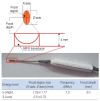Development of High-Intensity Focused Ultrasound Therapy for Inferior Turbinate Hypertrophy
- PMID: 33781059
- PMCID: PMC9149228
- DOI: 10.21053/ceo.2020.02383
Development of High-Intensity Focused Ultrasound Therapy for Inferior Turbinate Hypertrophy
Abstract
Objectives: Inferior turbinate (IT) hypertrophy is the main cause of chronic nasal obstruction. We developed a high-intensity focused ultrasound (HIFU) ablation device to treat patients with IT hypertrophy.
Methods: First, computed tomography images of patients with no evidence of sinonasal disease were evaluated to measure and compare the IT, medial mucosal thickness (MT), and space between the nasal septum and IT according to clinical characteristics such as septal deviation. A HIFU prototype was developed based on the above human anatomical studies. The experimental study was performed in five pigs; the nasal volume and histological changes at 1 and 4 weeks postoperatively were evaluated to compare the efficacy of HIFU turbinoplasty with that of radiofrequency turbinoplasty and a control group.
Results: The mean medial MT of the anterior, middle, and posterior portions of the IT were 4.66±1.14, 4.23±0.97, and 6.17±1.29 mm, respectively. The mean medial space was 2.65±0.79 mm. The diameter and focal depth of the prototype were 4 mm and 3 mm, respectively. HIFU showed no postoperative complications, including bleeding or scar formation. After HIFU treatment, the nasal volume increased by 196.62 mm3 (7.8%) and 193.74 mm3 (8.3%) at 1 week and 4 weeks, compared with the increase of 87.20 mm3 (3.1%) and 213.81 mm3 (9.0%), respectively, after radiofrequency therapy. A qualitative histological analysis after radiofrequency turbinoplasty showed epithelial layer disruption at 1 week and increased fibrosis, along with decreased glandular structure, at 4 weeks. The HIFU group had an intact epithelial layer at 1 week postoperatively. However, significant differences were observed at 4 weeks, including increased fibrosis and decreased glandular structure.
Conclusion: The efficacy and safety of HIFU turbinoplasty were demonstrated in an animal study. Our.
Results: warrant further human clinical trials.
Keywords: High-Intensity Focused Ultrasound Ablation; Postoperative Complications; Radiofrequency Therapy; Turbinates.
Conflict of interest statement
No potential conflict of interest relevant to this article was reported.
Figures






References
-
- Jenne JW, Preusser T, Gunther M. High-intensity focused ultrasound: principles, therapy guidance, simulations and applications. Z Med Phys. 2012 Dec;22(4):311–22. - PubMed
-
- Kennedy JE, Ter Haar GR, Cranston D. High intensity focused ultrasound: surgery of the future. Br J Radiol. 2003 Sep;76(909):590–9. - PubMed
Grants and funding
LinkOut - more resources
Full Text Sources
Other Literature Sources

